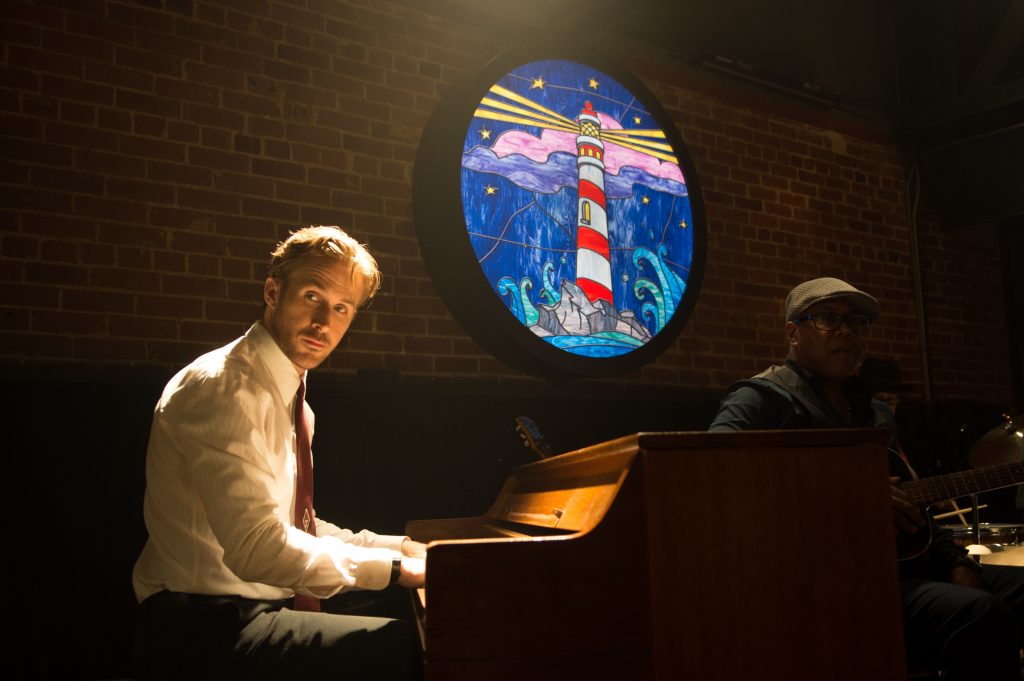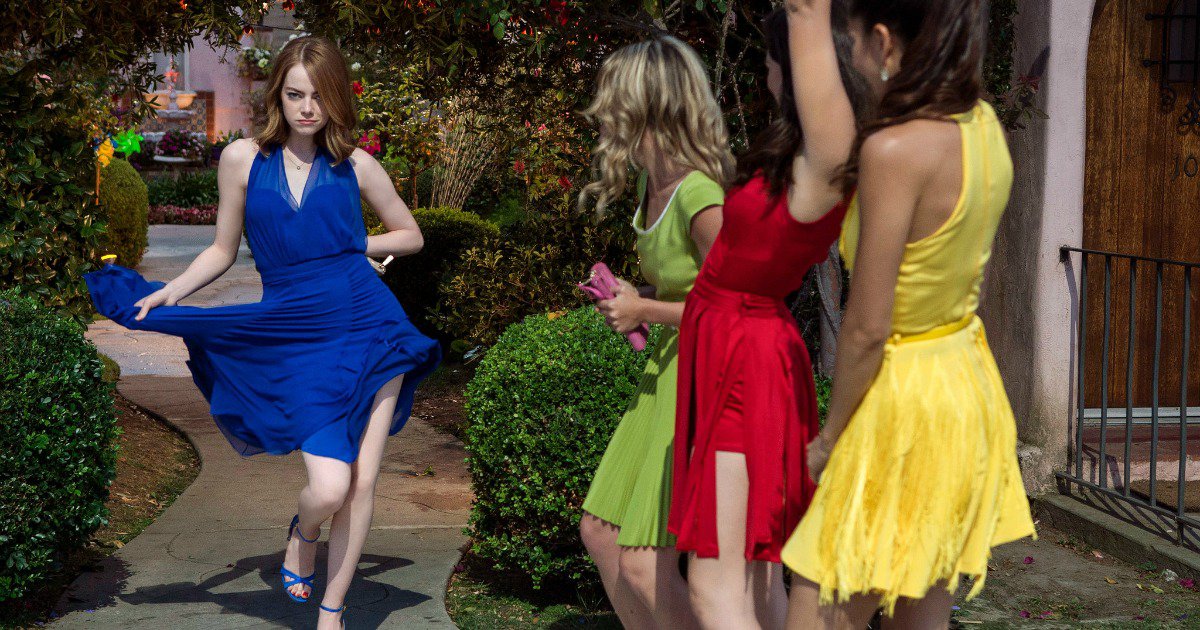By Kalvis Golde
Sometimes a movie’s reception tells as good a tale as the film itself. That certainly seems to be the case with “La La Land,” Damien Chazelle’s charming movie-musical about two Los Angeles romantics who fall in love as they chase their dreams down the city’s sprawling freeways.
From its inception as a small-screen hit, the movie quickly ascended to runaway acclaim and national buzz. First it tied the record for most Oscar nominations for a single film at 14. Next it swept the Golden Globes, a feat no movie had ever accomplished. Soon after, though, the juggernaut began to crack. Amid the showers of applause emerged cries that the film is empty and overrated or that it whitewashes the history of jazz. Backlash against a front-runner is predictable, but today, voices denouncing the film ring as loud as the praise. In the words of Toronto Star critic Peter Howell, “I can’t remember a year where the Oscar front-runner has attracted so much negativity in advance of awards night.”
This dramatic rise and fall in popularity has transformed “La La Land” from movie spectacle into internet meme. Analyzing the movie’s reception is now more in style than discussing the film itself. In the lead up to Oscar night, it’s worth taking a step back from the media circus surrounding “La La Land” to examine what the movie does well, and what it doesn’t.
The film’s first hour is compelling. It begins with a bang, a massive musical number atop a crowded L.A. freeway ramp. An enormous cast in bright-colored shirts and dresses ditch their cars to flip and dance around standstill traffic as they sing the anthem of the LA-dreamer: the relentless optimism of the crowd of young souls who travel West in search of fame, on screen or in the studio. Right from the start, the ambition of the film is on full display: the combination of music, choreography, and visual appeal outstrips anything else to come out of Hollywood this year.

From there, the plot takes off rapidly. Fleeting encounters between Sebastian (Ryan Gosling), a pianist who dreams of opening a jazz club to save the dying genre, and Mia (Emma Stone), a struggling actress with a string of failed auditions, quickly blossom into a textbook movie romance. Strong musical numbers follow so relentlessly that their love story soon becomes the unavoidable, sole focus: for most of the script, Gosling and Stone are the only two actors on screen. The rhythm of this opening arc is purely musical, even when no one is singing. It speeds. It slows. Inventive camera work causes scenes to skitter across Justin Hurwitz’s syncopated score.
The pace eventually slows to develop the plot, to mixed reviews. Some critics, like Observer’s Rex Reed, feel that “the movie sags badly in the middle, like a worn-out mattress that needs new springs.” At least, some moments feel overdone in an effort to maintain the excitement of the film’s beginning. During the Griffith Observatory scene, for instance, Chazelle veers into the realm of magical realism a bit too eagerly: Gosling and Stone actually fly into the air and dance around a galaxy of stars inside the planetarium before descending for their first on-screen kiss. The stunt feels out of place, despite the stunning visuals.
Another criticism is one levied at the actors themselves: neither Ryan Gosling nor Emma Stone are Broadway-caliber performers. To some critics, their at-times lackluster pitch and footwork come off as irritating, but to others, they add to the charm, making Sebastian and Mia more accessible characters. And certainly, Gosling and Stone do a respectable job. Chazelle recounts being impressed with Stone’s extreme diligence in learning the choreography, and her voice shines in Mia’s audition scene, one of the film’s high points. Gosling reportedly spent three months polishing his skills on the piano to prepare for Sebastian’s playing.
This brings us to perhaps the most serious critique raised by “La La Land” detractors. For a movie about jazz, it’s suspiciously short on African-American characters. There is nothing wrong with a white man who is passionate about jazz, but to some, Sebastian veers dangerously close to a white savior of a music genre so deeply rooted in black history. The only black character with spoken lines is Keith (John Legend), whom the film paints as almost villainous for his willingness to let jazz be corrupted by drum machines and electronic keyboards. It certainly would not have taken an extraordinary effort to remedy this dilemma — for instance, by casting a talented black actor in Sebastian’s role.

Despite these setbacks, the movie picks up near the end, building towards its high point in the final minutes. Mia and Sebastian separate to chase their own dreams; Mia leaves for Paris to shoot her debut movie, and Sebastian remains in L.A. to continue his fight for jazz. Chazelle then fast-forwards to Mia’s eventual return to Los Angeles, now a famous actress with a different husband and young daughter. Neither has spoken to the other, presumably, since their amicable split five years earlier.
Strolling down an evening-lit boulevard, Mia and her husband stumble upon a hopping jazz lounge. As fate would have it, the club belongs to Sebastian, who has succeeded in chasing his dream. Only after entering does Mia realize where she is, but she masks her turbulent emotions as she sits next to her husband in the audience. Sebastian takes the stage, and a pregnant silence is shared as the two notice each other. Regaining his composure, Sebastian takes his seat at the piano.
This forms the setup for the climax of the film, the epilogue. It’s a fantastic scene, and surely one of the most ambitious ever devised: 7 minutes and 39 seconds of extravagant montage all set to one exhilarating score, called simply “Epilogue” on the soundtrack. As Sebastian plays, Mia imagines the life they could have led, had they chosen to stay together and fight for their love along with their dreams.
Scenes from the previous two hours of the film race by, reimagined in striking color and fantastic whimsy. But this time, each pivotal decision proceeds differently; their happiness only grows as they choose each other over their careers at every turn. Musically, the feat is nothing short of epic, as all the earlier songs from the movie are woven, one-by-one, into a tapestry that tells the story of Mia and Sebastian without lyrics. The movement of the characters on screen is one choreographed dance, a fluid motion that adds to the dreamlike feel. References to classic movie-musicals abound.
The cumulative effect is, in a word, magical: I was rendered speechless for the entire seven minutes the first time I saw it. And the second time. The scene is so good, you don’t even mind that it reduces the previous two hours of plot to mere setup.

As Sebastian finishes playing and we resurface back in the club, the separation is re-affirmed: in the audience rests Mia; on the stage, Sebastian. Mia and her husband decide to leave, but not before she looks back on the doorstep at Sebastian, staring at her from behind the piano. They both smile. And then the pivotal decision occurs: Mia turns away and walks out the door after her husband. Sebastian looks down, still smiling, and then resumes the show as the credits begin to roll.
Not only is the epilogue of “La La Land” an artistic feat, but it also frames the key question raised by the movie: how do human beings find true happiness, by chasing our own dreams or a love with someone else? Director Damien Chazelle’s answer to this question rests on whether Mia and Sebastian are happy at the film’s end. In my opinion, they are. It’s likely that neither will feel the same intense joy or sorrow as they did with each other, but each seems content — Mia with her fame and family, Sebastian with his music. Both choose to move on with their own story, happy in knowing that each has forever changed the life of the other person. It warms and breaks your heart at the same time.
Despite the drama of hype and disapproval, “La La Land” is still a superb performance. Its storyline, despite the dangerous familiarity, feels new and exciting under Chazelle’s innovative direction. The movie certainly has its setbacks, but these are outweighed by its strengths: the sheer artistry of its production, the stellar performances by its leads, especially Emma Stone, and composer Justin Hurwitz’s triumphant score.
At first glance, the deluge of both praise and criticism showered on “La La Land” seems to have left no room to simply enjoy the movie. That is, until you sit down in the theater: the tour-de-force viewing experience is enough, even today, to wash away the peanut gallery. In the end, “La La Land” is a film worth watching — more than once, if you ask me.


